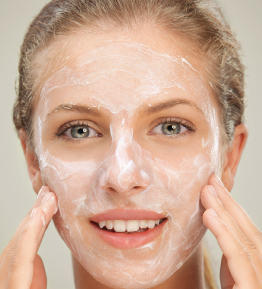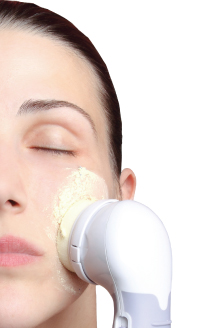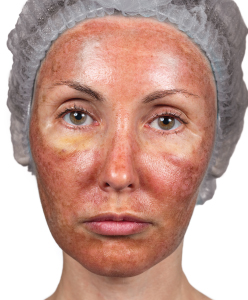We all know a necessary part of maintaining healthy skin is regular exfoliation. Removing the buildup of dead skin cells is essential for preventing fine lines and wrinkles, eliminating congestion in the hair follicles, reducing recurring acne breakouts, and helping to maintain a healthy complexion. Dead skin cell buildup also inhibits maximum results from topical skin care products.
As we age, the metabolic rate of cell turnover naturally begins to slow down. By sloughing dead skin cells off the surface, new healthy cells are stimulated. Accelerating the metabolic rate of cell renewal resets the aging clock back to a more youthful time of heightened cell growth. Without question, exfoliating the skin’s surface at different levels on a regular basis helps it to look brighter, evenly toned, fresh and radiantly youthful.
While both professional and home care exfoliating peels are a key aspect of any skin rejuvenating regimen, it is possible to over process the skin by taking resurfacing a step too far. Overexfoliating may result in undesired reactions such as stripping away the protective epidermal barrier and disrupting the natural moisture factor (NMF) of the skin, leading to water loss, dehydration, irritation, and excessive peeling beyond the intended result. When a peel solution is applied to the skin, it will seek its depth depending on the formulation, client’s skin type, and how their skin has been prepared to receive the solution. When combining peel solutions with mechanical devices, the potential for overexfoliation increases. In general, clients want the benefits of a skin peel without the side effects of red, peeling, irritated skin post-treatment. You always want to provide the very best result for your client, so you must be knowledgeable of their skin, the solution you are applying, and how their skin may react to the solution.
Overexfoliating at Home
 There is no doubt that clients are purchasing professional skin care products online. However, they are probably not aware of the risks associated with the application of professional products. Therefore, teaching your clients how to safely exfoliate their skin at home is an important part of your consultation and home care instructions. Offering your clients a microdermabrasion cream and peel products formulated for home use allows you to supervise and manage how they are exfoliating on their own.
There is no doubt that clients are purchasing professional skin care products online. However, they are probably not aware of the risks associated with the application of professional products. Therefore, teaching your clients how to safely exfoliate their skin at home is an important part of your consultation and home care instructions. Offering your clients a microdermabrasion cream and peel products formulated for home use allows you to supervise and manage how they are exfoliating on their own.
Home use peel formulations contain a lower concentration of exfoliating ingredients, usually between one and five percent, and are designed to help extend professional results. This ensures that the metabolic rate of cell renewal does not atrophy in between professional treatment sessions. Exfoliation should be mandatory homework to make home care treatment products more effective while ongoing weekly exfoliation conditions the skin to reduce sensitivity, irritation and the potential for complications from higher concentration professional peels. Home peels should be used once a week and can be layered similar to those in the treatment room. On clean skin, the client applies a manual microdermabrasion skin polish and gently works it into the skin, layering the polish with an enzyme or acid peel solution for five to 10 minutes.
 Skin rejuvenating treatment ingredients like retinol and glycolic, which are recommended for daily application, are exfoliating but also have the ability to speed up the rate of cell renewal which can cause reactions when first introduced to the skin. It may be necessary to adjust frequency of use of these recommended daily products to prevent dehydration, redness and irritation until the skin builds a tolerance to the stimulation. These types of treatments should be applied two or three times a week for the first couple of weeks and then increase frequency of use based on how the skin is tolerating the active agents. Keep in mind that if a client is using active ingredients like retinoids on a daily basis, peeling agents will be absorbed more quickly and to a much higher degree. Not being aware of this can be a major reason why the selected home peel solution results in an unexpected reaction or prolonged recovery.
Skin rejuvenating treatment ingredients like retinol and glycolic, which are recommended for daily application, are exfoliating but also have the ability to speed up the rate of cell renewal which can cause reactions when first introduced to the skin. It may be necessary to adjust frequency of use of these recommended daily products to prevent dehydration, redness and irritation until the skin builds a tolerance to the stimulation. These types of treatments should be applied two or three times a week for the first couple of weeks and then increase frequency of use based on how the skin is tolerating the active agents. Keep in mind that if a client is using active ingredients like retinoids on a daily basis, peeling agents will be absorbed more quickly and to a much higher degree. Not being aware of this can be a major reason why the selected home peel solution results in an unexpected reaction or prolonged recovery.
Before prescribing a skin care regimen, be aware of the ingredient formulations to be sure you are not combining products with active ingredients that offset each other. For example, retinol, as well as benzoyl peroxide, is good for treating acne, but because both products are exfoliating agents when mixed together, you can create excessive peeling, leading to unwanted complications like hyperpigmentation and inflammatory redness.
I continually coach clients on the best active ingredients for their skin type and concerns and then manage frequency of use throughout the day, so I know exactly how to work with their individual skin needs to avoid adverse, unexpected reactions.
Overexfoliating in the Treatment Room
 Professional peels include clinical and medical grade enzyme, acid and chemical peeling agents formulated in concentrations of 10 to 50 percent to produce the most dramatic and rapid changes to the skin. Layering peels with devices is usually recommended in cases where the skin’s condition is prematurely aged or has another challenging affliction that requires medium or deep epidermal exfoliation.
Professional peels include clinical and medical grade enzyme, acid and chemical peeling agents formulated in concentrations of 10 to 50 percent to produce the most dramatic and rapid changes to the skin. Layering peels with devices is usually recommended in cases where the skin’s condition is prematurely aged or has another challenging affliction that requires medium or deep epidermal exfoliation.
When trying to produce results for a client, be careful not to fall into the too much, too soon syndrome. It is better to treat on the moderate side until you really know the individual’s recovery rate from a peel procedure. Be extremely mindful of all aspects of the client’s health, lifestyle, skin type, color and tolerance prior to applying intensive professional peels to their skin.
Before applying any advanced peel protocol – where combinations of peel layers are used in tandem with a mechanical device – you must have an in-depth knowledge of how the client’s skin responds to this kind of intensive stimulation. It may take two or three treatment sessions, using lower concentrations of exfoliating ingredients to determine tolerance and sensitivity.
Additionally, your client’s commitment to post treatment compliance is an essential component of the treatment plan. Always provide clear written post-peel instructions. If they choose not to purchase the home care or do not follow your advice and if a complication occurs, then you have done your best to educate them.
To prevent potential complications, clients should be committed to a series of skin conditioning treatments prior to receiving advanced peeling treatments and a prescribed home care regimen, including melanin suppressing ingredients and sun protection. This prevents potential complications. While the client is in the process of conditioning the skin for deeper epidermal peeling, you must also be conditioning their mindset on what to expect from advanced procedures. Well informed clients are more likely to be compliant and, if a complication occurs, are less likely to be upset as they know the skin will recover satisfactorily in a short period of time.
Keep in mind that the skin type will determine the penetration of any peel. Some people have thick skin so if you prepare the skin with a microdermabrasion prior to applying an enzyme or acid peel solution, a much better result can be achieved from the increased penetration. People with dry skin do not absorb peel solutions as efficiently as oily skin types because the pores are not as open. In this case, microdermabrasion may be used as a peel preparation to open up the skin for better penetration. Dry skin types are slower to recover from exfoliation so it is important to select a peel solution with a lower concentration, depending on the degree of peeling desired to prevent overprocessing the tissue.
Layering is possible with most peels. An enzyme peel may prepare for microdermabrasion; glycolic acid may prepare for a salicylic peel; and lactic acid may prepare for dermaplaning, et cetera. You have many options available when it comes to performing advanced peel layering techniques.
An alternative option to the peel layering protocol is zone treating with your peel solutions. If a client has a lot of T-zone congestion and breakout, you can concentrate the exfoliation in that area to increase intensity. Perhaps the client has a lot of acne on the side of the face, but not so much in the T-zone. If so, concentrate on layering the treatments there. Target acne and discoloration with an acid peel prepared with a microdermabrasion on the outer zones or specific trouble spots if necessary.
Using a pre-peel degreasing procedure formulated with a blend of lower concentration acids or layering peels with microdermabrasion, opens up the skin for increased absorption of the peel solution. As a result of these preparatory techniques, the client is going to feel the peel more intensely. Ask the client how their skin is feeling on a scale of one to 10. If the sensation is off the chart, it may be necessary to disrupt the peel by removing it with ice water. But as the skin balances its own pH, the hot sensation will come down after about five minutes. If the skin is producing a mild erythema but not developing welting or blistering, then the peel is going according to the level of individual tolerance. Talk to the client until you have determined that it is time to remove the solution. If you are allowing it to self-time, remove it when the skin’s pH has turned off the peel and the client is comfortable.

Contraindications
Always refrain from layering on clients with skin disorders such as viral lesions, active herpes simplex, a history of keloidal scarring, recent plastic surgery, Accutane users, sunburned or hypersensitive skin, or recently waxed skin. Refrain from layering or using peel agents on clients who are using photosensitive or anticoagulant medication, have just received an injection or laser treatment, or are receiving radiation or chemotherapy.
Occasionally, reactions are going to happen. It is inevitable if you are using peels in your practice. If the skin is overexfoliated, the aim will be to accelerate healing for a rapid recovery. Using a burn protocol of ice or cool compresses, hydrocortisone and an ointment of 80 percent shea butter or even petroleum jelly to occlude the wound will aid the healing process, reducing the recovery time and preventing complications such as prolonged redness and flaking. Post-inflammatory complications can usually be resolved within three to 10 days. For severe reactions such as post-inflammatory hyperpigmentation or hypopigmentation, it can take up to 30 to 60 days with proper treatment to be resolved.
In conclusion, the best advice for applying peeling treatments without overexfoliating the skin is that if you are in doubt of the outcome, select a moderate exfoliation approach that you can be fairly certain of the reaction it will induce and the result it will produce for the client.
 27 years ago, Master Aesthetician, Lyn Ross founded Institut’ DERMed with the goal of empowering skin care specialists with knowledge and proven treatment systems for optimal success. The company, located in Atlanta, currently consists of a medical spa, a full line of cosmeceutical products distributed to spa’s nationally and internationally, and the Institut’ DERMed College of Advanced Aesthetics. Ross is a published author, with two books currently in print. Her articles appear in industry and trade magazines throughout the United States and worldwide.
27 years ago, Master Aesthetician, Lyn Ross founded Institut’ DERMed with the goal of empowering skin care specialists with knowledge and proven treatment systems for optimal success. The company, located in Atlanta, currently consists of a medical spa, a full line of cosmeceutical products distributed to spa’s nationally and internationally, and the Institut’ DERMed College of Advanced Aesthetics. Ross is a published author, with two books currently in print. Her articles appear in industry and trade magazines throughout the United States and worldwide.
Want to read more?
Subscribe to one of our monthly plans to continue reading this article.